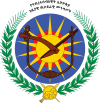This article needs additional citations for verification. (November 2023) |
Provisional Military Government of Socialist Ethiopia | |||||||||
|---|---|---|---|---|---|---|---|---|---|
| 1974–1987 | |||||||||
| Anthem: ኢትዮጵያ, ኢትዮጵያ, ኢትዮጵያ ቅደሚ Ītyoṗya, Ītyoṗya, Ītyoṗya, qidä mī (English: "Ethiopia, Ethiopia, Ethiopia be first") | |||||||||
 | |||||||||
| Capital | Addis Ababa | ||||||||
| Official languages | Amharic[1] | ||||||||
| Religion | State atheism | ||||||||
| Demonym(s) | Ethiopian | ||||||||
| Government | Unitary Marxist-Leninist one-party provisional government under a totalitarian military junta | ||||||||
| Head of state | |||||||||
• 1974 | Aman Andom | ||||||||
• 1974–1974 | Mengistu Haile Mariam | ||||||||
• 1974–1977 | Tafari Benti | ||||||||
• 1977–1987 | Mengistu Haile Mariam | ||||||||
| Legislature | None (rule by decree) | ||||||||
| Historical era | Cold War | ||||||||
| 12 September 1974 | |||||||||
| 21 March 1975[2] | |||||||||
| 22 February 1987 | |||||||||
| Area | |||||||||
| 1987[3] | 1,221,900 km2 (471,800 sq mi) | ||||||||
| Population | |||||||||
• 1987[3] | 46,706,229 | ||||||||
| Currency | Ethiopian birr (ETB) | ||||||||
| Calling code | 251 | ||||||||
| ISO 3166 code | ET | ||||||||
| |||||||||
| Today part of | |||||||||
| History of Ethiopia |
|---|
 |
The Derg (or Dergue; Amharic: ደርግ, lit. 'committee' or 'council'), officially the Provisional Military Administrative Council (PMAC),[4][5] was the military dictatorship that ruled Ethiopia, then including present-day Eritrea, from 1974 to 1987, when the military junta formally "civilianized" the administration but stayed in power until 1991.[6]
The Derg was established on 21 June 1974[7] as the Coordinating Committee of the Armed Forces, Police and Territorial Army, by junior and mid level officers of the Imperial Ethiopian Army and members of the police. The officers decided everything collectively at first, and selected Mengistu Haile Mariam to chair the proceedings. On 12 September 1974, the Derg overthrew the government of the Ethiopian Empire and Emperor Haile Selassie during nationwide mass protests, and three days later formally renamed itself the Provisional Military Administrative Council. In March 1975 the Derg abolished the monarchy and established Ethiopia as a socialist[8] state under a military-led provisional government. The abolition of feudalism, increased literacy, nationalization, and sweeping land reform including the resettlement and villagization from the Ethiopian Highlands became priorities. Mengistu became chairman in 1977, launching the Red Terror (Qey Shibir) political repression campaign to eliminate political opponents, with tens of thousands imprisoned and executed without trial.[9]
By the mid-1980s, Ethiopia was plagued by multiple issues, such as droughts, economic decline and increasing reliance on foreign aid, recovering from the Ogaden War, and the 1983–1985 famine from which the Derg itself estimated more than a million deaths during its time in power.[10] Conflicts between the Derg and various ethnic militias saw a gradual resurgence, particularly the Ethiopian Civil War and the Eritrean War of Independence. Mengistu formally abolished the Derg in 1987 and formed a Marxist-Leninist one party state, the People's Democratic Republic of Ethiopia led by the Workers' Party of Ethiopia, with a new government containing civilians but still dominated by members of the Derg.[11]
In May 1991, the Derg regime fell to the Ethiopian People's Revolutionary Democratic Front, ending the civil war that had been ongoing since 1974 following the toppling of the Ethiopian Empire.
- ^ The World Factbook (PDF). CIA. 1982. p. 85.
- ^ "Ethiopia Ends 3,000 Year Monarchy", Milwaukee Sentinel, 22 March 1975, p. 3.; "Ethiopia ends old monarchy", The Day, March 22, 1975, p. 7.; Henc Van Maarseveen and Ger van der Tang, Written Constitutions: A Computerized Comparative Study (BRILL, 1978) p. 47.; The World Factbook 1987; Worldstatesmen.org – Ethiopia
- ^ The World Factbook 1987
- ^ The World Factbook (PDF). CIA. 1982. p. 85.
- ^ Temesgen Gebreyehu (2010). "The Genesis and Evolution of the Ethiopian Revolution and the Derg: A Note on Publications by Participants in Events". History in Africa. 37: 321–327. doi:10.1353/hia.2010.0035. JSTOR 40864628. S2CID 144500147. Retrieved 18 July 2021.
- ^ Gebeyehu, Temesgen (2010). "The Genesis and Evolution of the Ethiopian Revolution and the Derg: A Note on Publications by Participant in Events". History in Africa. 37: 321–327. doi:10.1353/hia.2010.0035. JSTOR 40864628. S2CID 144500147.
- ^ Saheed A. Adejumobi, The History of Ethiopia (Greenwood Press, 2006) p.119
- ^ Gebeyehu, Temesgen (2010). "The Genesis and Evolution of the Ethiopian Revolution and the Derg: A Note on Publications by Participant in Events". History in Africa. 37: 321–327. ISSN 0361-5413. JSTOR 40864628.
- ^ de Waal 1991.
- ^ Gill, Peter (2010). Famine and Foreigners: Ethiopia Since Live Aid (PDF). Oxford University Press. pp. 43–44. ISBN 978-0-19-956984-7. Archived from the original (PDF) on 16 May 2018. Retrieved 30 April 2019 – via South African History Online.
The most eloquent summary of the famine's impact endorsed de Waal's conclusion. It came from the very top of Ethiopia's official relief commission. Dawit Wolde-Giorgis, the commissioner, was an army officer and a member of the politburo. Within two years of witnessing these events, he resigned from his post during an official visit to the United States and wrote an account of his experiences from exile. He revealed that at the end of 1985 the commission had secretly compiled its own famine figures—1.2 million dead, 400,000 refugees outside the country, 2.5 million people internally displaced, and almost 200,000 orphans. 'But the biggest toll of the famine was psychological,' Dawit wrote. 'None of the survivors would ever be the same. The famine left behind a population terrorized by the uncertainties of nature and the ruthlessness of their government.'
- ^ Korn, David A (1986). Ethiopia, the United States and the Soviet Union. Croom Helm. p. 179. ISBN 978-0-7099-3116-4. OCLC 1045940956.

